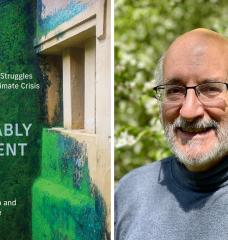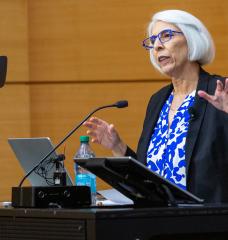
Lessons from coronavirus inform and enhance our understanding of needed next steps on climate change crisis.
By Gary Yohe, Henry Jacoby, Richard Richels and Ben Santer | Friday, October 30, 2020
Reposted from Yale Climate Connections
Let’s again explore why responding to climate change is so urgent, this time drawing lessons gleaned from our experiences with the novel coronavirus. And let’s take advantage of some of the increasingly obvious parallels between how both climate change and COVID-19 threaten society.
A deeper understanding of the risk
We begin with the mantra that “Uncertainty cannot be used as an excuse to put-off action on climate change.” When the world was ramping up to negotiate what became the Paris Climate Agreement, that point was emphasized to those maintaining that uncertainty about the workings of the climate system was too great to justify prompt action.
The way we think about the uncertainties surrounding climate impacts has been enriched by a combination of recent extreme climate events and the challenge of responding to COVID-19. For the virus, we do not know who will be infected next or where they are living, but we do know that countless Americans will continue to be infected over coming weeks and months. For climate change, we similarly do not know exactly where the next impacts will occur, but we do know that many people will soon have to face severe and sometimes lethal climate-related events.
For a single individual or a small community, uncertainty about exposure to climate change impacts or the ravages of a virus remains a matter of if something bad might happen.
But at larger scales, where public decisions are made, risks from climate and COVID are now matters of “when” – not if – events of potentially enormous consequence will happen. With inaction, adverse consequences come sooner, are harder to bear, and cost more to combat.
Another lesson from the pandemic
The viral pandemic has also focused a spotlight on the sources of perverse inequality in the widespread impacts of both of these threats. The risk of developing a serious COVID case, and perhaps even dying, is closely correlated with race, ethnicity and income level. And it is a long-standing conclusion of researchers that “the poor suffer most” from climate change.
Well redesigned and focused social investments informed by what the virus has taught us will help minimize some of these underlying inequities. Such investments will help with both public health and climate risks because our ability to respond to either or both depends on: equitable access to available resources; educational, socioeconomic and employment opportunities; and quality public safety, public health, and health care services.
Actions to fight climate change include policy measures, subsidies, and price penalties on emissions. With proper attention, our efforts to lower climate risks will complement policies designed to reduce social inequities, reducing those damages that fall most heavily on the disadvantaged. And, as our October 9th and 16th essays highlighted, market-based climate policies could also help lower costs of achieving climate targets and generate revenue to help meet societal needs.
What does successful mitigation look like?

Figure 1 illustrates some fundamental scientific facts about how mitigation can limit the increase in global mean surface temperature below some selected target. The top panel contrasts a continued “business as usual” pathway with one that caps annual global emissions by around 2050 and another that produces an 80% decline by around 2080. (The years, too late for action, of course; were chosen only to make the graph more legible.)
The lower panel translates them into three CO2 concentration pathways. This panel displays an immutable fact: concentrations depend on cumulative emissions, and temperature change depends on concentrations, so stabilizing emissions alone does not limit warming. To stabilize temperature, emissions must fall by 80% from their peak, doing so as efficiently as possible. When that reduction is achieved, natural activity in sinks and sources and feasible carbon sequestration initiatives can actually cancel emissions from human activity so that the zero emissions needed to provide stable global temperature can be achieved.
Near-term challenges are enormous
Meaningful progress against climate risks won’t come quickly or easily, especially since we have moved backwards in so many areas critically important to sustaining the public good. Because much has been broken, there is much to do fix over the short term even as we begin to work long-term to promote recovery from the human and economic damages caused by the coronavirus and our responses to it.
Progress in both areas could begin in earnest with leadership and overwhelming participation by the public at large. Then, we hope, the federal government will join in recognizing that climate change is a vast and growing problem, that it is caused by human activity, and that immediate action is necessary to mute its dangerous and accelerating impacts.
Whatever the results of next week’s elections, our capacity to move forward both on COVID and on climate needs involvement from all levels of government and society generally. As the next step in that regard, American citizens have a patriotic responsibility and privilege to make sure their 2020 election votes have been filed and that they count.
Gary Yohe is the Huffington Foundation Professor of Economics and Environmental Studies, Emeritus, at Wesleyan University in Connecticut. He served as convening lead author for multiple chapters and the Synthesis Report for the IPCC from 1990 through 2014 and was vice-chair of the Third U.S. National Climate Assessment.
Henry Jacoby is the William F. Pounds Professor of Management, Emeritus, in the MIT Sloan School of Management and former co-director of the MIT Joint Program on the Science and Policy of Global Change, which is focused on the integration of the natural and social sciences and policy analysis in application to the threat of global climate.
Richard Richels directed climate change research at the Electric Power Research Institute (EPRI). He served as lead author for multiple chapters of the IPCC in the areas of mitigation, impacts and adaptation from 1992 through 2014. He also served on the National Assessment Synthesis Team for the first U.S. National Climate Assessment.
Ben Santer is a member of the U.S. National Academy of Sciences. He served as convening lead author of the climate change detection and attribution chapter of the IPCC’s Second Assessment Report and has contributed to all five IPCC assessments.
Photo: American citizens are facing crucial decisions, beginning with their patriotic duty to vote. (Source: Yale Climate Connections)






